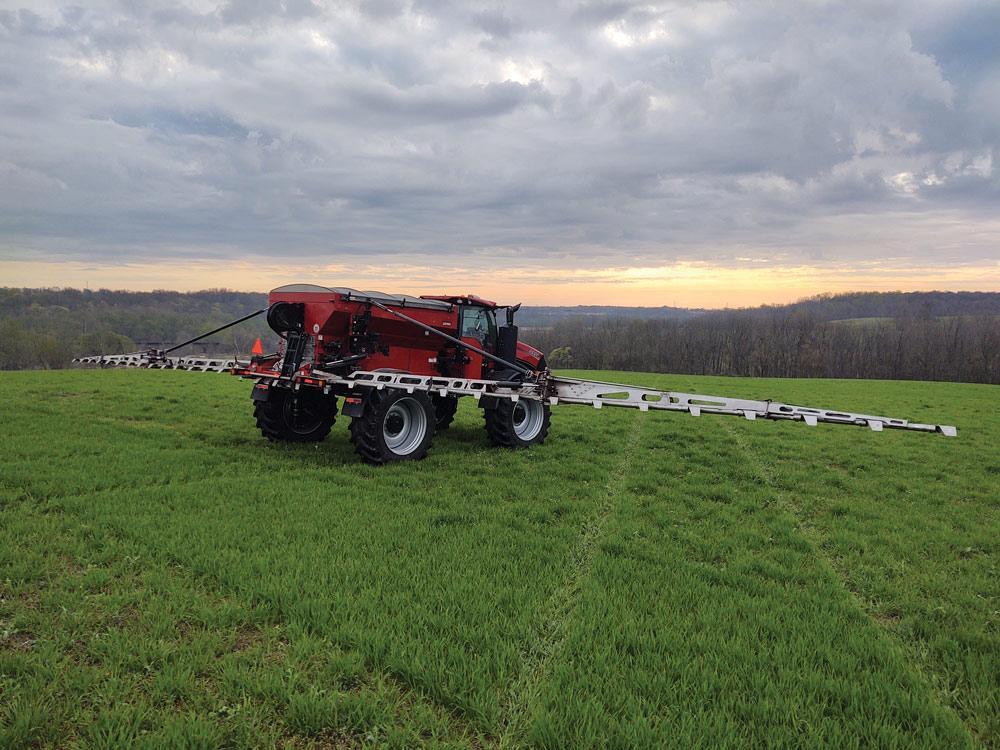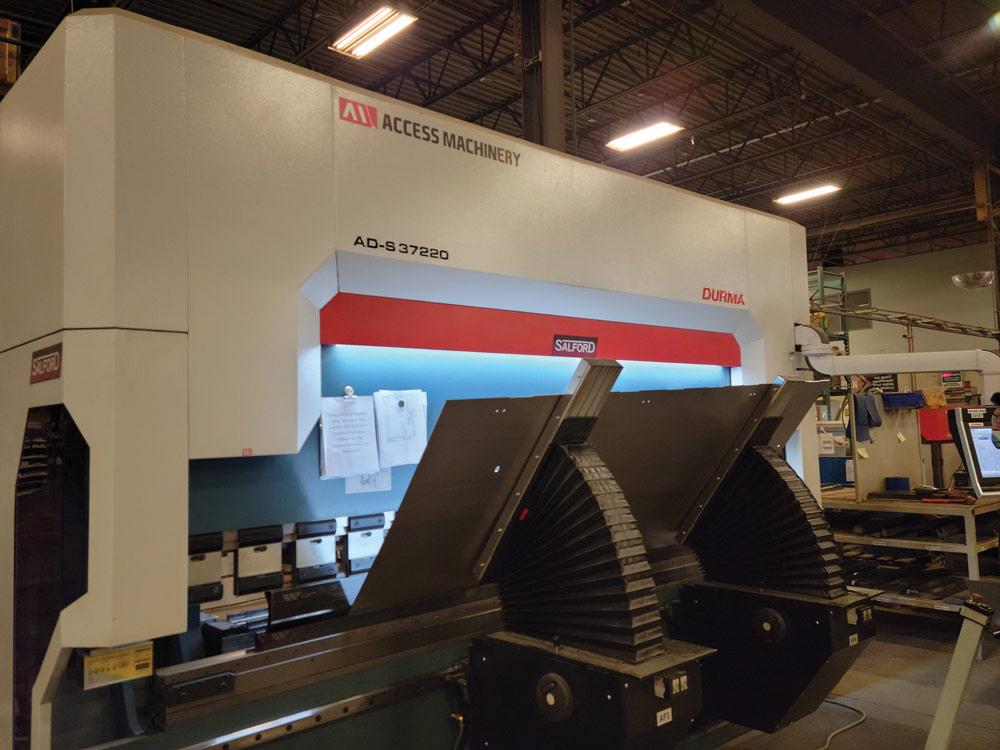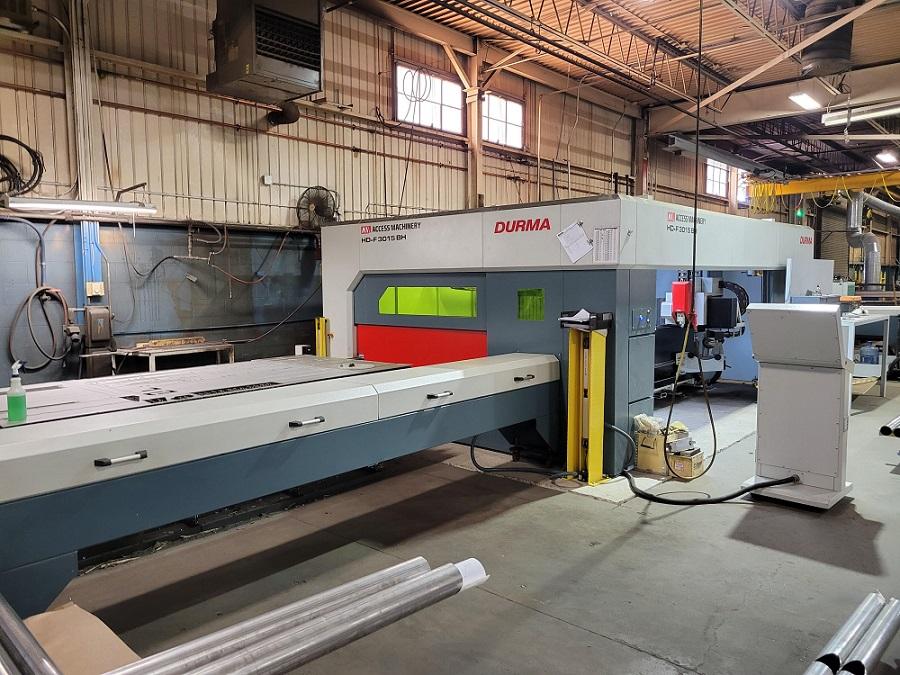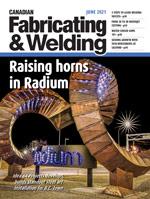Editor
- FMA
- The Fabricator
- FABTECH
- Canadian Metalworking
Seeding growth with tech investments at Salford Group
Salford Group manages a product mix shift with press brake, laser upgrades
- By Rob Colman
- July 1, 2021
- Article
- Fabricating

Pictured here is a Salford model 6700 air boom applicator mounted on a Case IH Trident high clearance chassis. The company invested in a new fibre laser to efficiently cut both plate and tube parts for this type of product. Images: Salford Group
Agricultural equipment, like fabrication equipment, has become more and more automated over the years. Like manufacturers, farmers are trying to do more work with fewer hands necessary in each process. Companies like Salford, Ont.-based Salford Group are in the business of helping them do so.
In the process of helping its customers innovate, Salford Group has had to upgrade and rethink its manufacturing processes. Most recently this has involved upgrading its press brakes and introducing a fibre laser machine to one of its facilities. These significant investments are steps along an innovation continuum for the multinational business.
History
Salford began production of conventional tillage equipment in 1978. Over the years the company grew with innovative tillage designs. In 2005 it began engineering and manufacturing seeding and application equipment as well.
Since that time the company has seen additional growth through acquisitions. In 2014 it purchased BBI Spreaders (founded in 1991), manufacturer of BBI Spinner Spreaders. In May 2015 it acquired Valmar Airflo (established in 1977), manufacturer of Valmar air boom and Valmar granular application tools. In December 2015 it purchased AerWay Advanced Aeration (established in 1983), manufacturer of AerWay aeration tillage and turf tools.
Salford, like BBI, Valmar, and AerWay, focuses on engineering easy-to-use equipment that incorporates innovations that are unique in the marketplace.
“We are not a high-volume producer like a John Deere,” said President Geof Gray. “We are a mid-volume niche product manufacturer focused on higher-end performance equipment.”
For those unaware of how far agricultural equipment has come, the technology involved is surprising.
“The technology is phenomenal today,” said Gray. “A lot of equipment is GPS guided, so that although there are drivers on these vehicles, like with a laser cutting machine in a fab shop, that person is there primarily to monitor what the equipment is doing. For instance, fertilizer deposition can be precisely managed down to the square foot, and the machine adapts on-the-fly. With GPS, low areas in a field can receive different amounts of fertilizer compared to high areas. Distribution can be changed with differences in soil quality.”
Salford has 530 employees in production facilities in Salford and Norwich, Ont.; Manitoba; Iowa and Georgia in the U.S.; and Siberia, Russia. Its Canadian operations employ approximately 300.

Salford most substantial press brake is the Durma AD-S 37220, a 220-metric-ton, 12 ft. brake equipped with sheet followers that assist in lifting material.
Working With Thin Gauge
For many years Salford’s focus on tillage equipment meant that most of its production involved thick plate. Any thin-gauge parts could be outsourced.
“Because of that, we used plasma for cutting and were able to use older press brakes for forming,” said Gray. “We didn’t require the precision that comes with working in thin-gauge materials.”
The fertilizing equipment the company now makes, however, requires cutting and forming stainless steel sheet and tube.
When it first began working in thin sheet, the company invested in four used CO2 lasers.
“At that time, although it wasn’t that long ago, fibre lasers weren’t as advanced as they are today,” said Paul Thomsen, Salford’s manufacturing project manager. “The CO2 lasers are still fully functional, and we use them every day, but as we grow, fibre lasers just make more sense.”
The company recently invested in a Durma HD-F 3015 BH 6-kW fibre machine with an optional tube/profile cutting feature.
“The fibre laser is more than three times faster on thinner sheets than the CO2,” said Thomsen. “In addition, the power supply is that much more efficient – you can see it in the size of the chiller it requires. But that was a secondary consideration to the speed of the fibre. The edge quality and accuracy are just that much better as well.
“The cost of repair and maintenance is also high on a CO2 laser,” he continued. “Those maintenance concerns will probably drive us to invest in more fibre lasers in the near future. There are just a lot more moving parts that can be affected on a CO2.”
About 90 per cent of what is cut on the fibre laser is flat sheet, and about 10 per cent is stainless steel tube used on the company’s Air Boom fertilizer spreaders. These systems blow fertilizer through tubes that precisely spread fertilizer via holes cut in those tubes. An example of such a system in use can be seen in the introductory photo.

The company recently invested in a Durma HD-F 3015 BH 6-kW fibre machine with an optional tube/profile cutting feature.
Service Support
The decision to invest in a Durma laser from Access Machinery stemmed from the relationship that already existed between the two companies.
“We have Durma machines in all of our facilities now,” said Gray. “We even have their equipment in our Russia facility, although we purchase that through a different distributor.”
Salford has purchased a number of Durma press brakes over the past few years. The most substantial of them is the Durma AD-S 37220, a 220-metric-ton, 12 ft. brake equipped with sheet followers that assist in lifting material.
“Each arm of the sheet follower can carry 250 kg,” said Thomsen. “Using the two in tandem improves safety and ergonomics for our operators, who sometimes have to bend panels as large as a full 5 by 10 sheet for the construction of hopper bins. The work can be difficult without that support.”
As good as a machine is, it’s generally the service that builds a relationship with a machine tool supplier.
“Access has been great to work with in terms of service,” said Thomsen. “For instance, since the installation of the laser, they’ve been able to assist us remotely with questions we’ve had. They’ve logged into the system remotely, with our permission, to either show us how to do something we hadn’t yet done or support our operator who had forgotten something they’d been taught in training. Being able to show the operator on screen what needs to be done rather than talking it through with them on the phone makes it much easier. It’s also much more convenient than waiting for an in-person service call.”
Constant Innovation
Salford is a company that is determined to continually find efficiencies in its operations. Beyond the cutting and forming department, this has included investments in robotic welding, as well as CNC machining and turning processes.
It was with continuous innovation in mind that Thomsen’s position was created several years ago.
“There were always people concerned with investments in efficiencies at the company, but that role was always secondary to their main responsibilities,” said Thomsen. With a specific role dedicated to finding efficiencies, Thomsen can help management find opportunities and prioritize them depending on requirements and resources.
“I investigate any cost-saving possibilities, whether it be insourcing products we’ve been outsourcing, or finding appropriate equipment to make our parts more efficiently, whether it be laser cutting or a machining or turning centre,” said Thomsen. Once machines are in place, Thomsen project-manages their installation and the training required on the machines.
But he is quick to point out that the changes the company makes inevitably are a team effort.
“For instance, every time we sit down and redesign our shop floor to improve product flow, we make sure we have input from everyone who will be affected to ensure we do it right,” he said.
To make both the fibre and CO2 lasers more efficient, Thomsen has also introduced a higher-performance nesting software that can maintain a remnant inventory for the shop to improve sheet utilization.
“We are always moving,” he said. “We are always looking to get more productivity from every square foot of the manufacturing floor. In fact, we are so happy with Durma and Access Machinery that we purchased a second 6-kW laser that will be installed in a few weeks.”
The last year has been good for Salford, as its fortunes followed those of the commodity markets.
“2020 was a very good year for us,” said Gray. “We were going full-out through the pandemic with record sales. Now we are ready to expand our footprint again to meet the needs of the market.”
Editor Robert Colman can be reached at rcolman@canadianfabweld.com.
Access Machinery, www.accessmachinery.ca
Salford Group, www.salfordgroup.com
About the Author

Rob Colman
1154 Warden Avenue
Toronto, M1R 0A1 Canada
905-235-0471
Robert Colman has worked as a writer and editor for more than 25 years, covering the needs of a variety of trades. He has been dedicated to the metalworking industry for the past 13 years, serving as editor for Metalworking Production & Purchasing (MP&P) and, since January 2016, the editor of Canadian Fabricating & Welding. He graduated with a B.A. degree from McGill University and a Master’s degree from UBC.
subscribe now


Keep up to date with the latest news, events, and technology for all things metal from our pair of monthly magazines written specifically for Canadian manufacturers!
Start Your Free Subscription- Industry Events
Automate 2024
- May 6 - 9, 2024
- Chicago, IL
ANCA Open House
- May 7 - 8, 2024
- Wixom, MI
17th annual Joint Open House
- May 8 - 9, 2024
- Oakville and Mississauga, ON Canada
MME Saskatoon
- May 28, 2024
- Saskatoon, SK Canada
CME's Health & Safety Symposium for Manufacturers
- May 29, 2024
- Mississauga, ON Canada





















